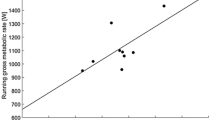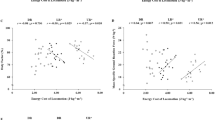Summary
This study was designed to examine the interrelationships between performance in endurance running events from 10 to 90 km, training volume 3–5 weeks prior to competition, and the fractional utilization of maximal aerobic capacity (%\(\dot V_{O_{2max} } \)) during each of the events. Thirty male subjects underwent horizontal treadmill testing to determine their\(\dot V_{O_{2max} } \), and steady-state\(\dot V_{O_2 }\) at specific speeds to allow for calculation of %\(\dot V_{O_{2max} } \) sustained during competition. Runners were divided into groups of ten according to their weekly training distance (group A trained less than 60 km · week−1, group B 60 to 100 km · week−1, and group C more than 100 km · week−1). Runners training more than 100 km · week−1 had significantly faster running times (average 19.2%) in all events than did those training less than 100 km · week−1.\(\dot V_{O_{2max} } \) or %\(\dot V_{O_{2max} } \) sustained during competition was not different between groups. The faster running speed of the more trained runners, running at the same %\(\dot V_{O_{2max} } \) during competition, was due to their superior running economy (19.9%). Thus all of the group differences in running performance could be explained on the basis of their differences in running economy. These findings suggest either that the main effect of training more than 100 km · week−1 may be to increase running economy, or that runners who train more than 100 km · week−1 may have inherited superior running economy. The finding that the maximal horizontal running speed reached during the progressive maximal treadmill test was a better predictor (r=0.72) of running performance at all distances than was the\(\dot V_{O_{2max} } \) (r=0.54) suggests that peak treadmill running speed can predict performance in endurance running events.
Similar content being viewed by others
References
Conley DL, Krahenbuhl GS (1980) Running economy and distance running performance of highly trained athletes. Med Sci Sports Exerc 12:357–360
Conley DL, Krahenbuhl GS, Burkett LN (1981) Training for aerobic capacity and running economy. Phys Sports Med 9:107–115
Conley DL, Krahenbuhl GS, Burkett LN, Millar AL (1984) Following Steve Scott: Physiological changes accompanying training. Phys Sports Med 12:103–106
Costill DL (1972) Physiology of marathon running. JAMA 221:1024–1029
Costill DL, Thomason H, Roberts E (1973) Fractional utilization of the aerobic capacity during distance running. Med Sci Sports 5:248–252
Daniels J (1974) Running with Jim Ryun: A five year study. Phys Sports Med 2:62–67
Daniels J (1974) Physiological characteristics of champion male athletes. Res Q 45:342–348
Daniels JT, Yarbrough RA, Foster C (1978) Changes in\(\dot V_{O_{2max} } \) and running performance with training. Eur J Appl Physiol 39:249–254
Davies CTM, Thompson MW (1979) Aerobic performance of female marathon and male ultramarathon athletes. Eur J Appl Physiol 41:233–245
Dotan R, Rotstein A, Dlin R, Inbar O, Kofman H, Kaplansky Y (1983) Relationships of marathon running to physiological, anthropometric and training indices. Eur J Appl Physiol 51:281–293
Ekblom B, Astrand PO, Saltin B, Stenberg J, Wallstrom B (1968) The effect of training on the circulatory response to exercise. J Appl Physiol 24:518–528
Farrell PA, Wilmore JH, Coyle EF, Billing JE, Costill DL (1979) Plasma lactate accumulation and distance running performance. Med Sci Sports 11:338–344
Foster C (1983)\(\dot V_{O_{2max} } \) and training indices as determinants of competitive running performance. J Sports Sci 1:13–22
Foster C, Daniels JT, Yarbrough RA (1977) Physiological and training correlates of marathon running performance. Aust J Sports Med 9:58–61
Hagan RD, Smith MG, Gettman LR (1981) Marathon performance in relation to maximal aerobic power and training indices. Med Sci Sports Exerc 13:185–189
Hagberg JM, Coyle EF (1983) Physiological determinants of endurance performance as studied in competitive racewalkers. Med Sci Sports Exerc 15:287–289
Hill AV, Lupton H (1923) Muscular exercise, lactic acid and the supply and utilization of oxygen. Quart J Med 6:135–171
Jones NL, Campbell EJM (1982) Clinival exercise testing. Second edition. W. B. Saunders Co., London, pp 231–243
LaFontaine TP, Londeree BR, Spath WK (1981) The maximal steady state versus selected running events. Med Sci Sports Exerc 13:190–192
Leger L, Mercier D (1984) Gross energy cost of horizontal treadmill and track running. Sports Med 1:270–277
Lehmann M, Berg A, Kapp R, Wessinghage T, Keul J (1983) Correlations between laboratory testing and distance running performance in marathoners of similar performance ability. Int J Sports Med 4:226–230
Maughan RJ, Leiper JB (1983) Aerobic capacity and fractional utilization of aerobic capacity in elite and non-elite male and female runners. Eur J Appl Physiol 52:80–87
Pollock ML, Jackson AS, Pate RR (1980) Discriminant analysis of physiological differences between good and elite distance runners. Res Q 51:521–532
Rhodes EC, McKenzie DC (1984) Predicting marathon time from anaerobic threshold measurements. Physcn Sports Med 12:95–98
Robinson S, Harman PM (1941) The effects of training and of gelatin upon certain factors which limit muscular work. Am J Physiol 133:161–169
Saltin B, Gollnick PD (1983) Skeletal muscle adaptability: Significance for metabolism and performance. In: Peachey LD (ed) Handbook of physiology, Section 10. Skeletal muscle. Chapter 19. American Physiological Society, Bethesda, Maryland, pp. 555–631
Siegel S (1956) Nonparametric statistics for the behavioral sciences. McGraw-Hill Kogakusha Ltd., Tokyo
Sjodon B, Jacobs I (1981) Onset of blood lactate accumulation and marathon running performance. Int J Sports Med 2:23–26
Sjodin B, Schele R (1982) Oxygen cost of treadmill running in long distance runners. In: Komi, PV (ed) Exercise and sport biology. Human Kinetics Publishers, Champaign, Illinois, pp 61–67
Slovic P (1977) Empirical study of training and performance in the marathon. Res Q 48:769–777
Sparling PB (1984) Physiological determinants of distance running performance. Phys Sports Med 12:68–77
Wasserman K, Whipp BJ, Koyal SN, Beaver WL (1973) Anaerobic threshold and respiratory gas exchange during exercise. J Appl Physiol 35:236–243
Williams C, Nute MLG (1983) Some physiological demands of a half-marathon race on recreational runners. Br J Sports Med 17:152–161
Williams CG, Wyndham CH, Kok R, von Rahden MJE (1967) Effect of training on maximum oxygen intake and on anaerobic metabolism in man. Int Z Angew Physiol 24:18–23
Author information
Authors and Affiliations
Rights and permissions
About this article
Cite this article
Scrimgeour, A.G., Noakes, T.D., Adams, B. et al. The influence of weekly training distance on fractional utilization of maximum aerobic capacity in marathon and ultramarathon runners. Europ. J. Appl. Physiol. 55, 202–209 (1986). https://doi.org/10.1007/BF00715006
Accepted:
Issue Date:
DOI: https://doi.org/10.1007/BF00715006




